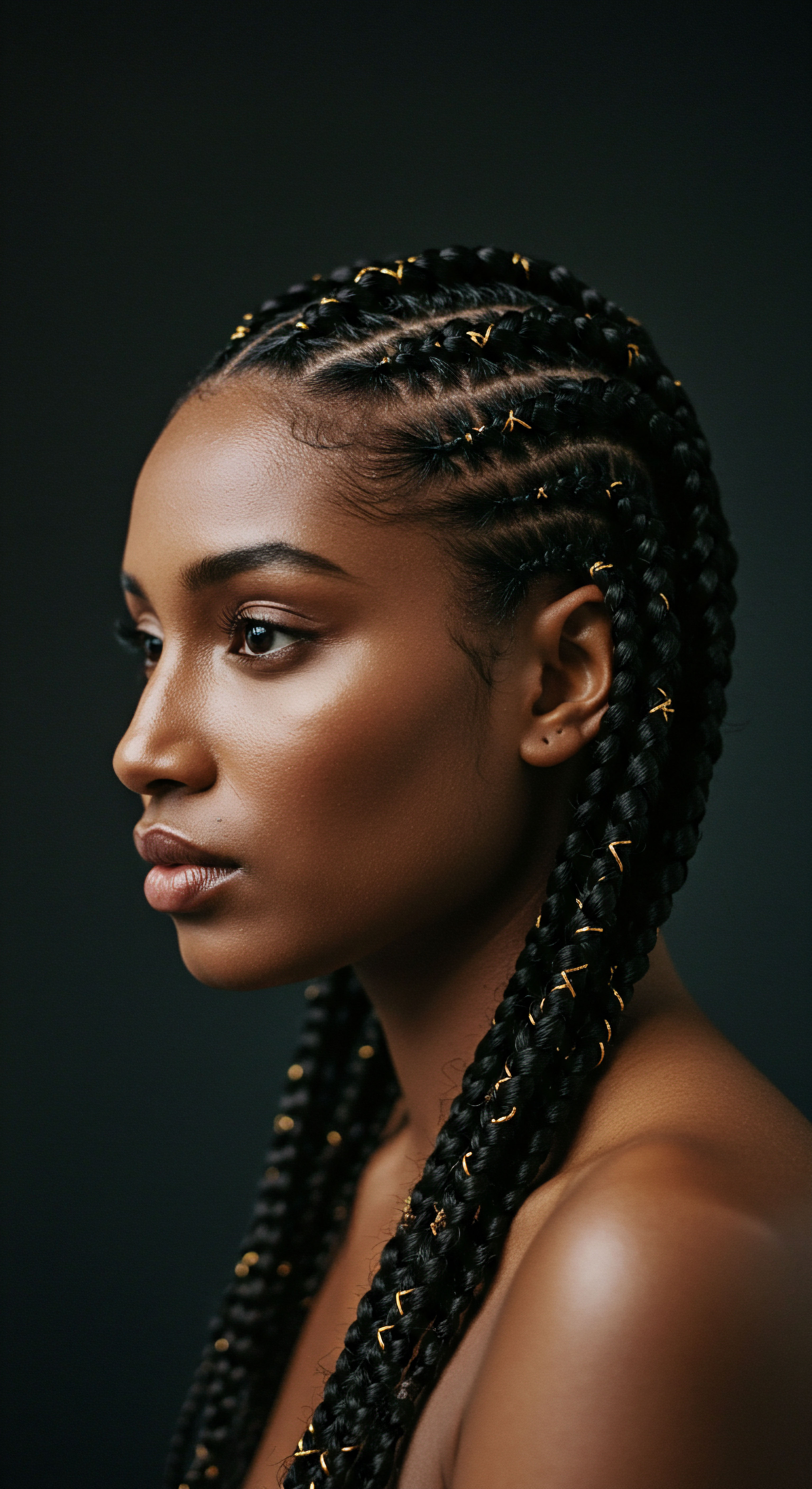
Fundamentals
The concept of “Ancient Textiles,” when viewed through the lens of Roothea, a resource devoted to textured hair, particularly Black and mixed hair, extends far beyond simple fabric. It encompasses the profound historical connection between human ingenuity, the natural world, and the adornment, protection, and cultural meaning woven into hair itself. At its core, this phrase invites us to consider the very first instances where humanity utilized fibers – whether from plants, animals, or even spun human hair – to interact with and enhance hair, especially the unique structures of curls, coils, and waves. It speaks to a time when every adornment, every protective wrap, held a deeply embedded cultural meaning, reflecting identity, status, and spiritual connection.
Think of it as an initial understanding, a gentle opening to a vast historical garden where every strand of hair, every piece of woven material, tells a story of survival, creativity, and self-expression. The definition of Ancient Textiles here is not merely about archaeological finds; it is an exploration of how early societies, particularly those in Africa, recognized the intrinsic qualities of hair as a fiber and crafted ingenious solutions for its care and presentation. This includes the development of tools, the selection of natural materials, and the cultivation of communal rituals surrounding hair, all of which predate modern cosmetic science.
Ancient Textiles represent the foundational relationship between early human societies, natural fibers, and the profound cultural significance of hair adornment and protection.
The earliest known textiles, dating back thousands of years, were not solely for clothing. They found their way into personal grooming and beautification, offering a tangible understanding of how communities engaged with their environment to nurture and celebrate their hair. For instance, evidence from ancient Egypt shows the use of human hair, wool, and plant fibers to create elaborate wigs and extensions, often adorned with precious materials to signify wealth and status. These practices demonstrate a sophisticated grasp of fiber manipulation and its potential for both aesthetic and practical purposes.

Early Applications in Hair Care
The earliest applications of textile-like materials in hair care were often born from necessity and a deep understanding of hair’s delicate nature. Consider the use of natural fibers for creating rudimentary hair coverings. These coverings served as protection from harsh environmental elements like the sun, dust, and insects, a practical consideration for communities across various climates. Beyond mere utility, these items quickly acquired symbolic value, signifying social standing, marital status, or tribal affiliation.
- Plant Fibers ❉ Early communities utilized fibers from indigenous plants, such as raffia palm in West and Central Africa, or flax in ancient Egypt, to craft hair adornments and protective wraps. These materials offered breathability and often possessed inherent properties beneficial for hair.
- Animal Fibers ❉ Wool and fine animal hair were also used, sometimes woven into textiles or directly incorporated into hairstyles. Such applications highlight an early recognition of different fiber characteristics and their suitability for various hair needs.
- Human Hair ❉ The practice of incorporating human hair into extensions or wigs was widespread in ancient civilizations, showcasing an early form of hair augmentation that mirrors modern practices. This demonstrated an understanding of how to add volume and length using existing hair structures.
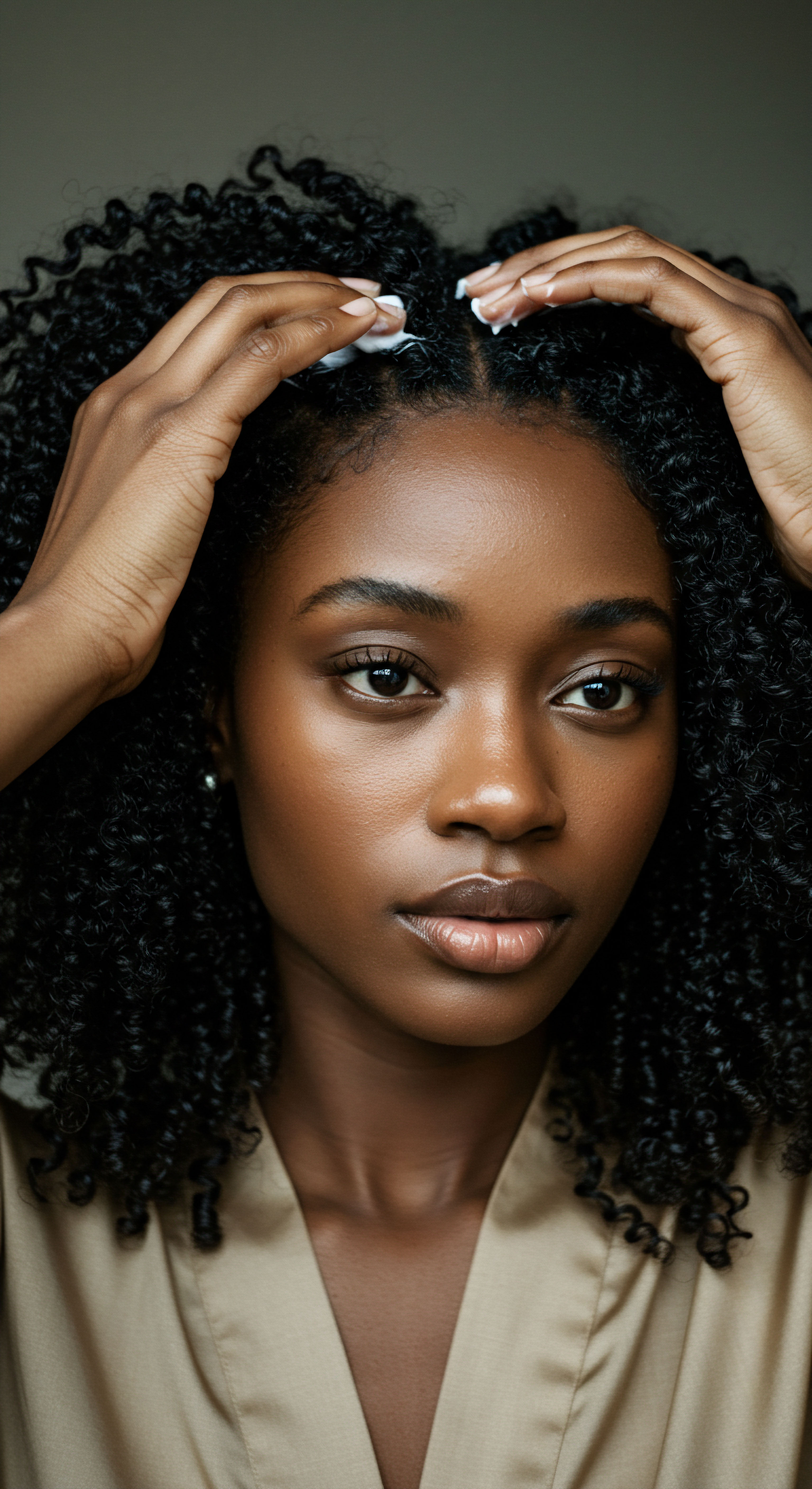
The Cultural Delineation of Hair
In many ancient African societies, hair was more than just an anatomical feature; it was a powerful medium for communication, conveying intricate details about an individual’s identity and their place within the community. The styles, the adornments, and the very act of hair care were deeply intertwined with cultural values and spiritual beliefs. For example, specific braid patterns could denote marital status, age, or even a person’s clan. This level of specification in hair practices meant that the textiles and materials used in conjunction with hair were not chosen arbitrarily; they were selected for their symbolic significance and their ability to enhance these visual narratives.
The historical record reveals that hair maintenance was a communal activity, often lasting hours or even days, providing opportunities for social bonding and the transmission of cultural knowledge. The materials used in these rituals, from natural oils and clays to beads and shells, alongside textile elements, formed a holistic system of care and cultural expression. This early approach to hair care offers a foundational perspective on the inherent connection between material culture, personal identity, and communal well-being, particularly for textured hair, which naturally lends itself to diverse styling and adornment.

Intermediate
Moving beyond the foundational comprehension, an intermediate understanding of Ancient Textiles in the context of textured hair invites us to delve deeper into the interplay of material science, cultural resistance, and the enduring legacy of ancestral practices. Here, the meaning of Ancient Textiles expands to encompass not only the physical fibers and fabrics but also the ingenious methods by which they were integrated into hair care and styling, often as a means of protection and a silent declaration of identity amidst adversity. This level of understanding highlights the practical applications and profound implications for daily and weekly hair care rituals within Black and mixed-race hair experiences.
Consider the nuanced relationship between ancient protective styles and the textiles that accompanied them. Head wraps, for instance, were not simply decorative coverings; they were sophisticated tools for hair preservation. They shielded delicate strands from environmental aggressors, helped maintain moisture balance, and provided a canvas for intricate cultural expression. The choice of fabric, its texture, and the manner of wrapping all held specific implications for hair health and cultural communication, a testament to generations of accumulated wisdom.
Ancient Textiles, in a more advanced sense, signify the deliberate application of fibrous materials for protective styling and cultural expression, particularly within textured hair traditions, serving as a testament to resilience.

Protective Applications and Hair Physiology
The physiological characteristics of textured hair, with its unique elliptical cross-section and propensity for coiling, make it particularly susceptible to moisture loss and mechanical stress. Ancient communities intuitively understood these vulnerabilities, developing practices that leveraged textile properties to mitigate them. Silk, for example, known for its smooth surface and low absorbency, would have been an ideal material for reducing friction and retaining hair’s natural oils, even if its widespread availability varied by region. Conversely, coarser fibers might have been used for their structural integrity in supporting elaborate styles.
The historical use of specific materials in protective styles offers a valuable lesson for contemporary textured hair care. While modern science can explain the mechanisms, ancient practices demonstrate an empirical understanding of what works.
| Method Head Wraps (Gele, Duku, Doek) |
| Associated Textile/Material Cotton, Silk, various patterned cloths |
| Primary Benefit for Textured Hair Shields from sun/dust, retains moisture, reduces tangles |
| Method Braiding with Extensions |
| Associated Textile/Material Plant fibers (e.g. raffia), wool, human hair |
| Primary Benefit for Textured Hair Adds length/volume, protective styling, reduces manipulation |
| Method Hair Nets/Bands |
| Associated Textile/Material Silk, finely woven plant fibers |
| Primary Benefit for Textured Hair Maintains style, prevents frizz, reduces friction |
| Method Hair Adornments (Beads, Shells) |
| Associated Textile/Material Often integrated with braids/twists |
| Primary Benefit for Textured Hair Secures styles, adds weight for elongation, cultural symbolism |

The Resilience of Head Wraps
The story of head wraps, particularly within the African diaspora, stands as a compelling case study of how Ancient Textiles transcended their initial functional and symbolic roles to become powerful instruments of resistance and cultural continuity. During periods of enslavement, head coverings, often made from coarse or mandated fabrics, were imposed upon Black women as a symbol of subservience. Yet, enslaved women ingeniously transformed these symbols of oppression into canvases for coded communication and defiant self-expression. In places like Suriname, folds in headscarves conveyed secret messages, a silent language understood only by those who shared the burden of bondage.
This deliberate act of reclaiming and reinterpreting the head wrap underscores its enduring meaning. Post-emancipation, while some Black women abandoned head coverings to assimilate into Eurocentric beauty standards, the head wrap experienced a powerful resurgence during the Black Power movement of the 1960s and 1970s. It became a potent emblem of Black identity, pride, and a conscious rejection of imposed beauty norms.
This evolution highlights how textiles, originating in ancient practices, continued to serve as dynamic tools for self-definition and cultural affirmation across generations. The resilience of these practices speaks volumes about the deep connection between hair, textiles, and identity.
This historical trajectory offers a profound understanding of the practical and psychological dimensions of hair care for textured hair. It illustrates how ancient textile practices, far from being relics of the past, hold lessons for contemporary approaches to protective styling, moisture retention, and the celebration of natural hair.
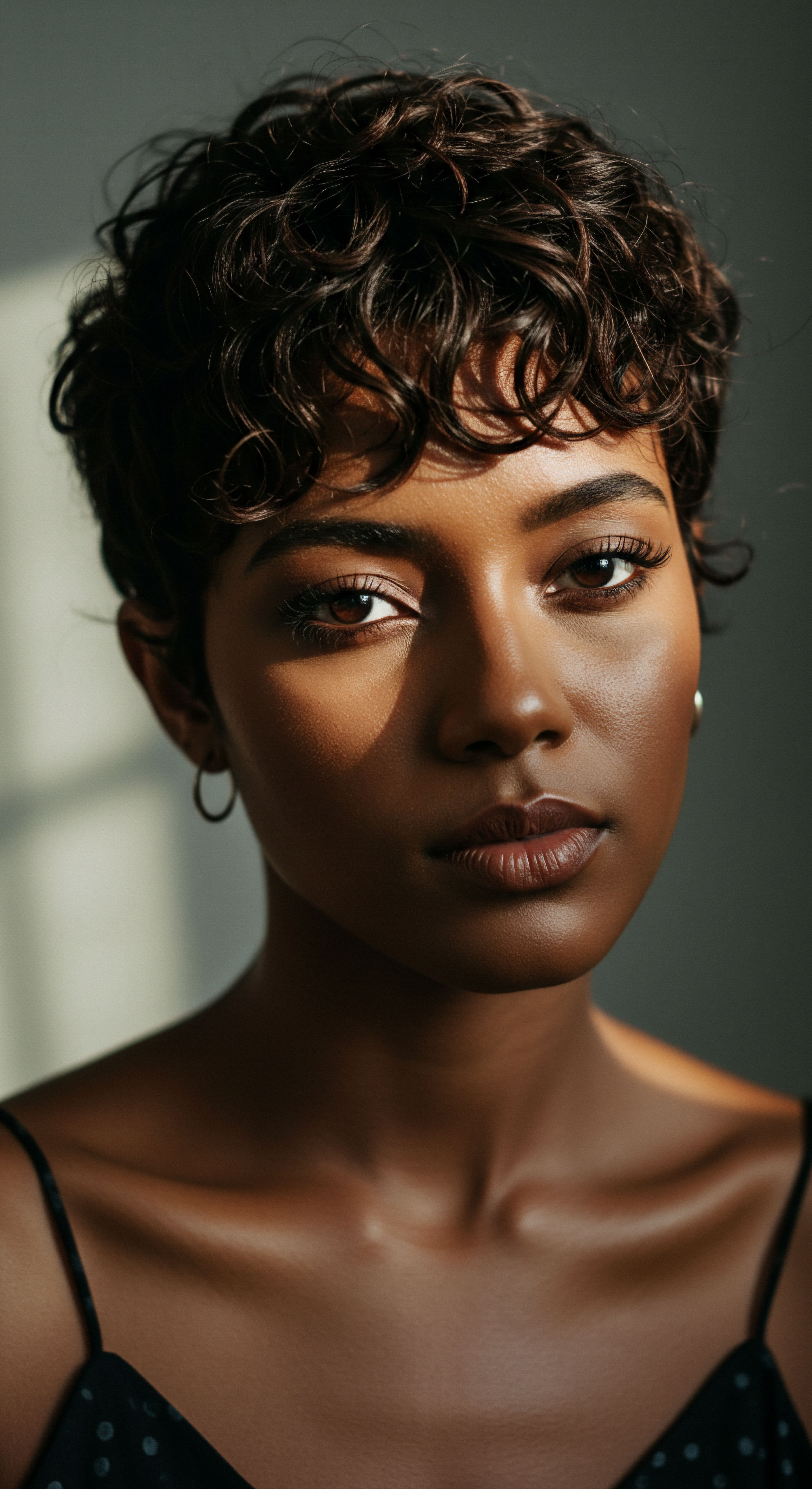
Advanced
The profound meaning of “Ancient Textiles,” within the scholarly and expert discourse concerning textured hair, particularly Black and mixed-race hair heritage and science, signifies a complex, interwoven understanding. This concept extends beyond the literal archaeological discovery of fabric fragments; it encompasses the inherent material properties of hair itself as a biological textile, the sophisticated indigenous knowledge systems that developed around its care, and the enduring cultural lexicon articulated through its adornment with fibrous elements. It represents a theoretical framework for appreciating the long-term consequences and societal insights derived from centuries of interaction between human hair, natural fibers, and the cultural practices that shaped identity.
This advanced interpretation acknowledges that textured hair, with its distinct structural morphology—ranging from elliptical cross-sections to varied curl patterns and high disulfide bond density—presents unique challenges and opportunities for care and styling. Ancient textile applications were not merely cosmetic; they were informed by an empirical, often holistic, understanding of hair’s needs, predating modern trichology. This perspective compels us to consider the profound implications of these historical practices on hair health, cultural preservation, and the ongoing dialogue surrounding Black hair identity in a globalized world.
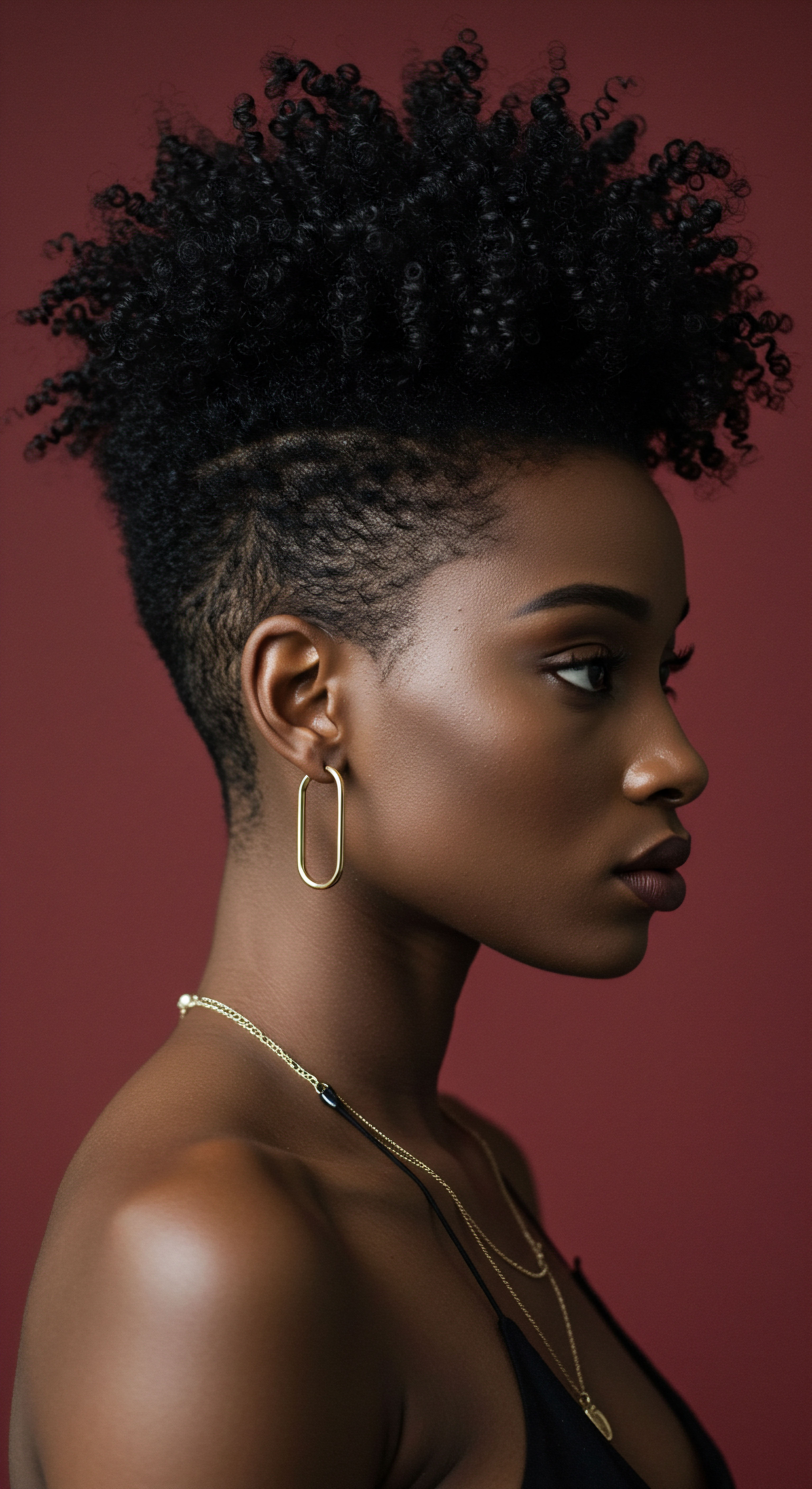
Hair as a Biological Textile ❉ A Structural Explication
To comprehend the deep relationship between Ancient Textiles and textured hair, one must first recognize hair itself as a remarkable biological textile. Each strand possesses a complex hierarchical structure, comprising the cuticle, cortex, and medulla. The cuticle, the outermost layer, consists of overlapping scales that protect the inner cortex.
The cortex, the most substantial portion, contains keratin proteins arranged in macrofibrils, dictating hair’s mechanical strength and elasticity. The medulla, a central core, contributes to volume and texture, though its presence varies with hair thickness.
For textured hair, the unique helical twisting of cortical cells and the elliptical cross-sectional shape contribute to its characteristic coiling. This curvature, while visually striking, also renders textured hair more vulnerable to mechanical stress and breakage compared to straighter hair types. Ancient civilizations, through observation and inherited wisdom, developed methods that intuitively addressed these inherent structural properties.
The selection of smooth, low-friction fibers like silk for nightly wraps, for example, directly mitigated cuticle damage and moisture evaporation, a practice now validated by modern hair science. This early understanding of hair as a delicate fiber, requiring specific material interaction, forms a crucial part of the Ancient Textiles discourse.
The historical engagement with fibrous materials for hair care offers a compelling case study in applied material science, revealing ancestral knowledge of hair’s biological textile properties.
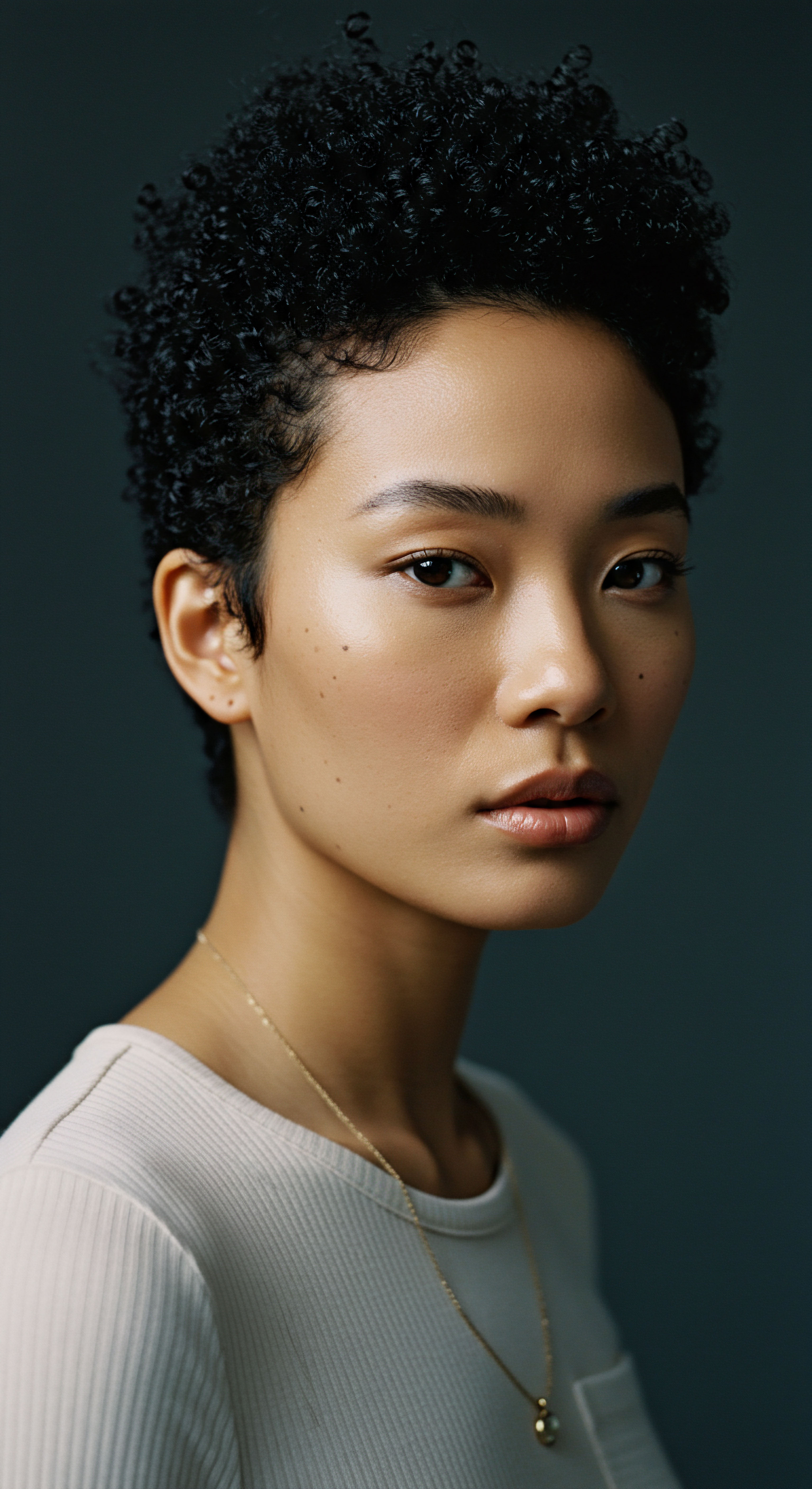
The Socio-Economic Impact of Textile-Hair Intersections
The long-term consequences of ancient textile practices extend into socio-economic spheres, particularly evident in the colonial era’s deliberate suppression of African hair traditions. During the transatlantic slave trade, the forced shaving of hair was a systematic act of dehumanization, designed to strip enslaved Africans of their identity and cultural connection. This act severed a profound link to ancestral practices where hair, often adorned with textiles and natural elements, conveyed marital status, age, wealth, and spiritual beliefs.
A striking, perhaps controversial, instance of this intersection is the Tignon Law of 1786 in Louisiana . This edict mandated that free women of color wear a tignon, a head covering, to distinguish them from white women and suppress their perceived “exotic allure.” This policy, rather than diminishing their presence, inadvertently became a catalyst for defiant artistry. Women of color transformed these mandated head wraps into elaborate, vibrant statements, adorning them with jewels, ribbons, and feathers, effectively subverting the law’s oppressive intent. This historical episode offers a powerful example of how textiles, initially imposed as tools of control, were reappropriated as instruments of resistance and self-assertion.
The creativity displayed in transforming a symbol of inferiority into one of undeniable beauty and agency reveals a profound resilience. This socio-historical dynamic continues to influence the perception and politics of Black hair today, highlighting the enduring legacy of Ancient Textiles as a battleground for identity and freedom.
This historical narrative underscores the importance of acknowledging the complex legacy embedded within seemingly simple objects like head wraps. It reveals how ancient textile practices, far from being isolated historical curiosities, carry deep societal insights into the enduring struggle for self-determination and the power of cultural expression. The very choice of material, the technique of wrapping, and the context of wear were all meticulously crafted elements within a larger system of communication and survival.
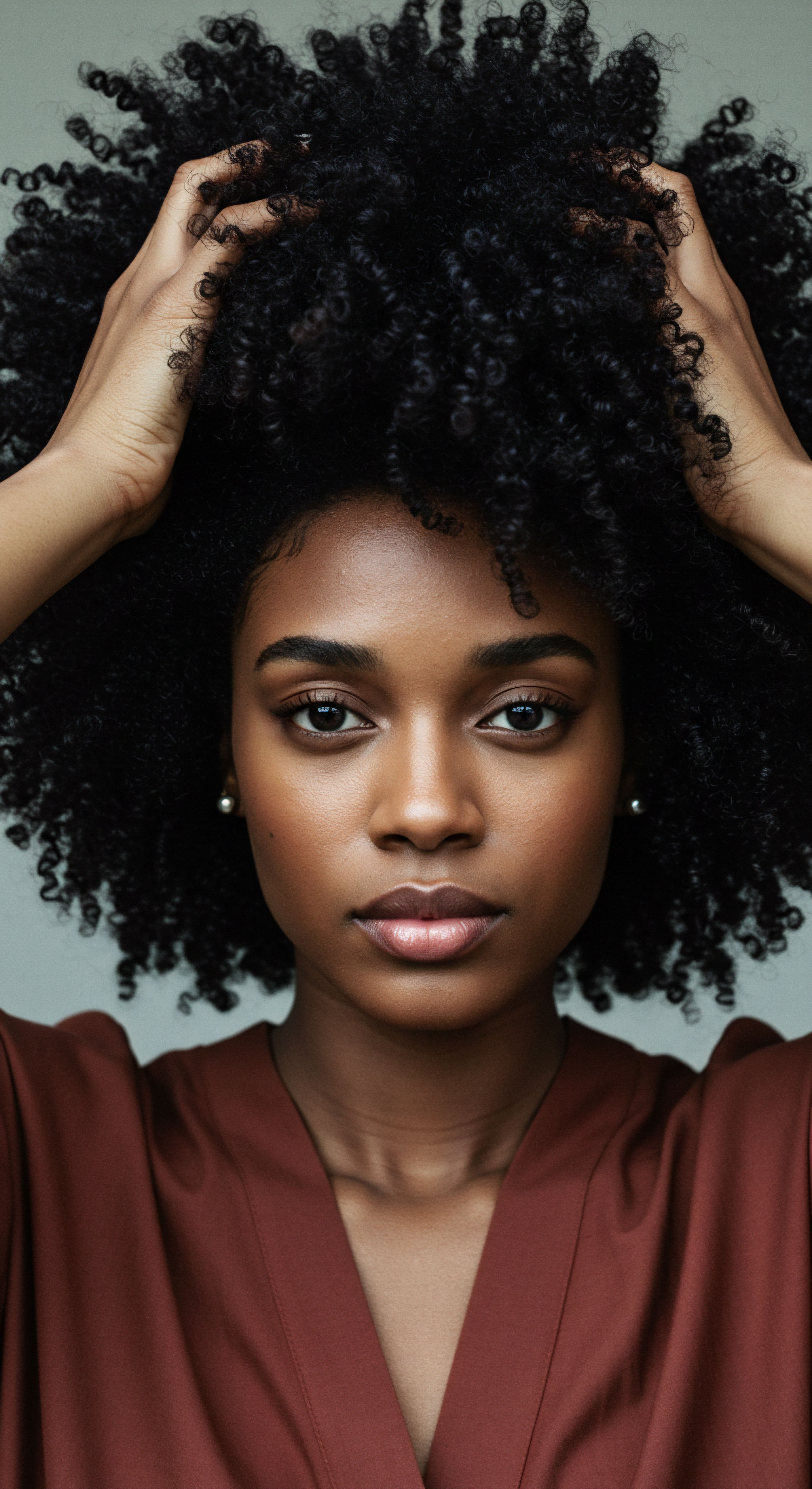
Indigenous Knowledge Systems and Material Innovation
The sophistication of ancient textile applications for textured hair also reflects advanced indigenous knowledge systems. Communities understood the properties of different plant fibers—such as their absorbency, durability, and texture—and selected them accordingly for various hair-related purposes. For example, certain plant fibers were used for extensions, providing volume and length, while others might have been processed into softer materials for protective wraps or adornments.
This deep level of material innovation was often passed down through oral traditions and communal practices, forming a rich heritage of hair care that celebrated the natural qualities of textured hair. The deliberate use of natural elements like ochre, animal fat, and various beads alongside woven materials for dreadlocks and other intricate styles in communities like the Himba further exemplifies this profound connection between the environment, human artistry, and hair care. These practices were not merely functional; they were ritualistic, connecting individuals to their lineage, their community, and the spiritual realm. The comprehensive understanding of Ancient Textiles therefore requires appreciating this interplay of scientific observation, cultural heritage, and the continuous innovation in material use.

Reflection
As we conclude our exploration of Ancient Textiles through the vibrant lens of textured hair, a sense of profound appreciation settles upon us for the enduring wisdom of our ancestors. These historical practices, far from being mere relics of a distant past, echo with a quiet yet powerful resonance in our contemporary hair journeys. They remind us that the care of textured hair, particularly Black and mixed hair, has always been an intricate dance between understanding its unique biological rhythms and honoring its deep cultural significance. The deliberate choice of fibers, the thoughtful artistry of protective styles, and the resilient spirit embedded in every wrap and adornment speak volumes about identity, community, and survival.
This journey through ancient practices encourages a gentle re-evaluation of our modern routines, prompting us to consider the holistic well-being of our strands not just chemically, but also culturally and spiritually. It is a gentle whisper from the past, inviting us to rediscover the innate connection between our hair, the earth’s bounty, and the stories woven into the very fabric of our heritage. There is a delicate beauty in recognizing that the quest for healthy, celebrated textured hair is not a new endeavor, but a timeless pursuit rooted in the ingenious and compassionate traditions of those who came before us.

References
- Oforiwa, A. (2023). The History and Culture of African Natural Hair ❉ From Ancient Times to Modern Trends. AMAKA Studio.
- Tharps, L. M. & Byrd, A. D. (2001). Hair Story ❉ Untangling the Roots of Black Hair in America. St. Martin’s Press.
- Walker, A. (1992). The Color Purple. Harcourt Brace Jovanovich. (Though a novel, its cultural impact on Black hair narratives is significant.)
- Katsande, R. (2015). The history & meaning of head wraps across Africa. Wilderness Safaris.
- Cybulska, M. & Maik, J. (2007). Archaeological Textiles – A Need for New Methods of Analysis and Reconstruction. FIBRES & TEXTILES in Eastern Europe, 15(5-6), 185-188.
- Okocha, A. E. (2017). Exploration of Hairstyles for Fabric Designing and Production. International Journal of Innovative Research & Development, 6(1), 31-35.
- Agbadudu, A.B. & Ogunrin, F.O. (2006). Aso-oke ❉ a Nigerian classic style and fashion fabric. Journal of Fashion Marketing and Management ❉ An International Journal, 10(1), 97–113.
- Sivakumaran, P. et al. (2022). How different is human hair? A critical appraisal of the reported differences in global hair fibre characteristics and properties towards defining a more relevant framework for hair type classification. International Journal of Cosmetic Science, 44(6), 661-674.
- Popescu, D. (2020). Appearance of protective clothing over the centuries. TEKSTILNA INDUSTRIJA, 68(4), 38-44.
- Gabra-Sanders, T. (2002). Textiles, textile fibres and animal hairs, dyes and ropes. In A. S. Cameron and J. A. Stones, Aberdeen ❉ an In-depth View of the City’s Past, Society of Antiquaries of Scotland Monograph Series No.19, 222-41.